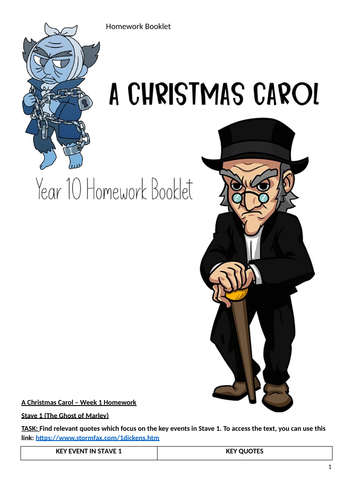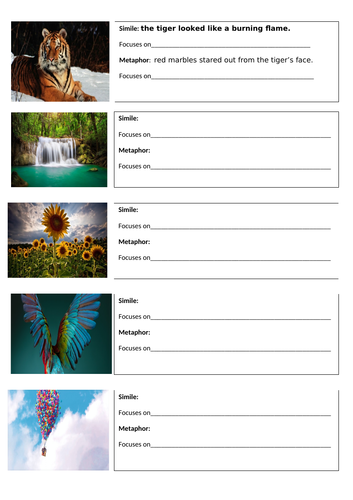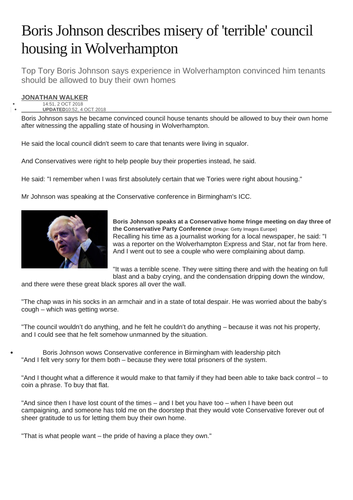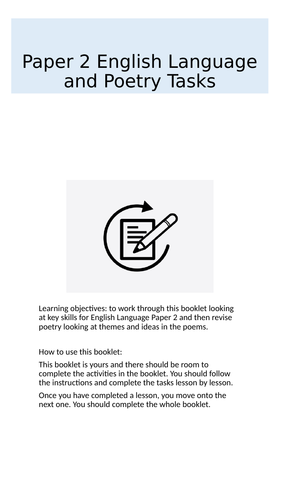
41Uploads
2k+Views
1k+Downloads
All resources

Poetry Analysis Extract from Out of the Blue by Simon Armitage KS3
Another cover or poetry analysis grid. Part of our unseen poetry scheme where students had scaffolded questions and were taken through a series of tasks to complete. Worked well.

AQA Style Year 9 Animal Farm Mock Assessment Questions
A series of mock assessment questions for Year 9 leading up to end of year exams - really good for in class practice using the mark scheme to mark them.

Poetry Analysis KS3 Mother Any Distance by Simon Armitage
A cover sheet or full poetry analysis lesson with Mother Any Distance - this was part of our unseen poetry scheme whereby students were guided through a series of questions considering authorial intent.

A Christmas Carol Homework Booklet Year 10
A 6 week homework booklet designed for recalling what had been covered in lesson. At no point was this put together to necessarily challenge but more to reiterate and strengthen what had been studied from tasks and the novella.
I found it useful and students learnt and recapped ideas easier which then assisted the learning within lesson. Great for going through under a visualiser and peer assessing answers, and for stengthening speaking and listening.

A Level English Language Grammar Worksheets
These worksheets were used as independent study sessions/homework to ensure that the students were learning outside of the curriculum. Feel free to download and hope they are useful!

Paper 1 Question 3 Structure - Lovefield
One lesson that I use to introduce structure to students studying it for the first time. It really helps and film or short movie clips are a great way of tracking structure and thinking about the ideas surrounding it.

Paper 1 Questions 1-4 and Source A
Used as revision and for a mini in lesson test for Paper 1 in Year 10 - used for a mid to low ability set to ease them in with confidence.

A Level English Language Meanings and Representations Independent Work
Here are a couple of articles with questions to make Year 12 think about Meanings and Representations. This was sent as independent learning and then discussed in lesson before having a go at answering Q1/Q2 on Paper 1 of the A Level Language paper.

Two Reading For meaning Extracts and Questions
I started Reading for Meaning worksheets with my Year 10 students (high ability) to get them analysing what other writers do and why.
The questions should be scaffolded and they take the students through some ideas about the writer.

Unseen Poetry Task Mat - D. H. Lawrence
This was created for a Year 9 set with a range of tasks to assist their approach to the unseen poetry scheme of work we were doing.
Questions have been scaffolded to aid their learning and understanding. Also used for a Year 10 and Year 11 set when studying unseen poetry.

KS4 Literacy Booklet 1 AQA Style (details of contents in description)
Here is a 30 page Key Stage 4 Literacy Booklet which is designed for intervention for low ability KS4 students or in class use (there is lined paper to answer questions embedded). The exam board is AQA and this booklet is in the STYLE of this at the end. Below is what is in the booklet for you:
The booklet begins with students:
revising punctuation
identifying word classes
going over inference skills
And then the students have a quiz to recap what they have done. The booklet then continues with:
extract and language focus questions
quote exploding some quotations with language features
language focus question
comprehension skills on a Harry Potter extract
language match up table expanding language features
reading activities choices page
Then the booklet moves to:
more AQA style questions giving an overview of paper 1 and paper 2
Great Expectations by Charles Dickens focus by practicing paper 1 questions 1, 2 and 5
Extract from Jane Eyre and then tasks to follow with paper 1, questions 1, 2 and 5 focus
Then a final vocabulary gathering activity
My students found this helpful and communication with parents/carers was great over this. We started it in Year 10 and then went back to bits in Year 11.

AQA Power & Conflict Poetry London - William Blake Low Ability Lesson
A low ability lesson for Year 10 when starting to teach power and conflict poetry. Mine liked it due to the videos that aided the lesson.

A Level English Literature Transition Work KS4 to KS5 Specification B Crime & Tragedy
Here is a small booklet including transition work for the open days of A Level English Literature - it is a small booklet to aid teaching the class for the new recruits!

A Christmas Carol 5 Lessons Staves 1 - 4
Made for a set 3 target grades 4-6 English Literature group.
These 5 lessons were designed for a first reading of A Christmas Carol - the lessons took longer than 5 hours as I also used the Disney version to play sections of the film to clarify what was happening, but there was a lot of modelling when we annotated the novella under visualisers and completed an assessment as well.
There are close reading sections with an abundance of analysis questions, quotation focus tasks and theme and plot questions too.

Paper 1 Question 3 and Question 4 Revision Year 11 English Language
This is a booklet using The Handmaid’s Tale focusing on question 3 structure and question 4 evaluation revision for Year 11. It’s designed for a set 2 and a set 3 in mind.
There are bits of advice, flipped learning questions, analysis of questions (to be done under the visualiser), mark schemes for those questions and model answers that can be adapted and then carried on.

Exposure Poetry Low Ability Lesson
This lesson goes through the poem for a low ability group. It has activities about the soldier’s feelings, an overview of the poem and then some focused quotation analysis linking to technique finding and why Owen will have written it.
Students enjoyed this lesson before going into more detail later on in the year.

The Laboratory x3 Lessons Crime Poetry A Level English Literature
This contains 3 lessons for The Laboratory with integrated context, analysis and tasks for students to complete when teaching The Laboratory. I have also included a copy of the annotated poem to assist the teaching of this poem.
The three lessons will last 3 hours and when annotating the poem, this should be done under a visualiser. The tasks for students could be set as independent study time or homework, and will assist the further learning of the course.

Paper 1 Question 5 Creative Writing Revision Booklet
This is a creative writing booklet for Paper 1 Question 5 that takes students through how to practice their writing. It has been used as a homework booklet and has spaces to write as well as a self relection on the back.
There is text to analyse and pictures to help with their planning or writing.

Chapters 23-27 The Murder of Roger Ackroyd Narrative Structure and Plot
Here we have two lessons in one powerpoint exploring the narrative plot and framing devices that Christie uses. There are slides with tasks on and other slides for students to take notes from. I have also included a document which is like a transcript for the lesson going through the information minus the tasks.
The lesson should take two lessons and it is the students considering Christie’s authorial methods whilst also understanding the ending. It is the assumption that students have already read the whole novel.
It is going over set-piece ending, framing devices and back to focalisation.
Hopefully this will help when teaching.

Key Stage 4 Cover Booklet (Low Ability 6 Lessons)
This is 6 lessons worth of a cover booklet focusing on Key Stage 4 AQA English Language Paper 2 and Poetry Tasks. This was set for a low ability group so there may be more than 5 lessons attached.




















